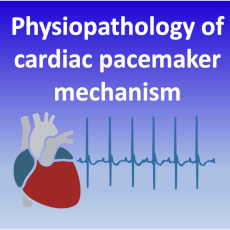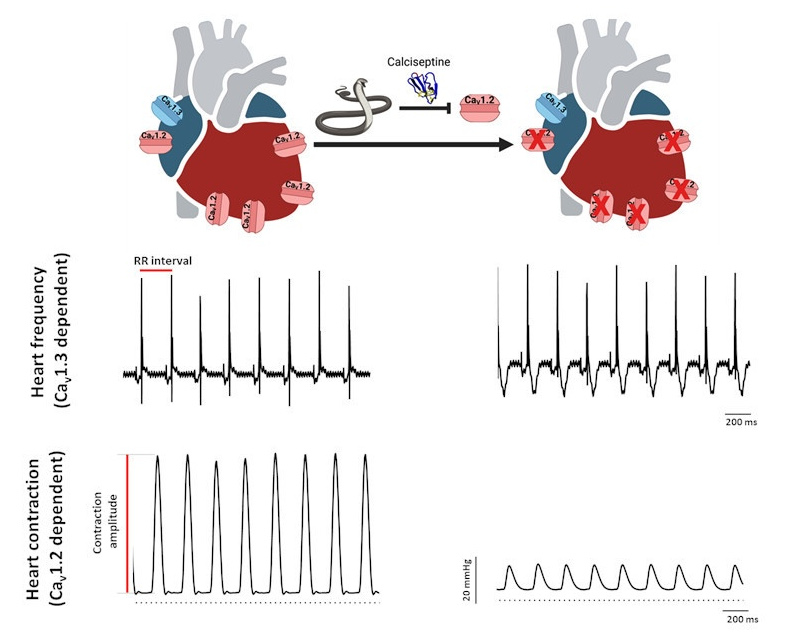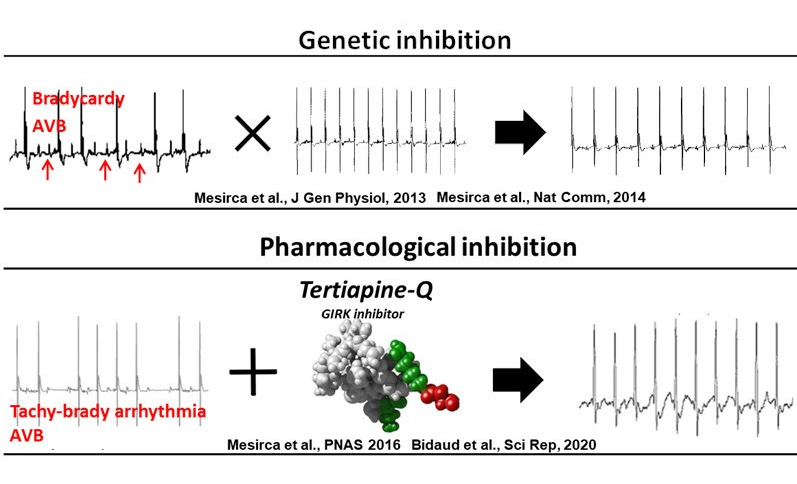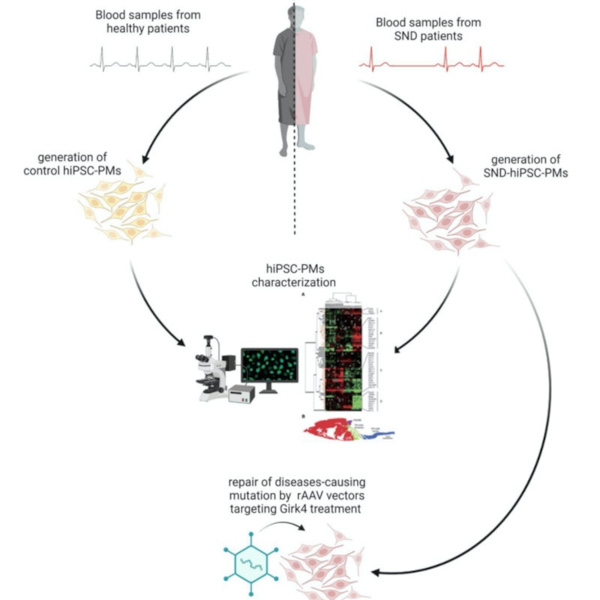Team Stéphanie BARRÈRE-LEMAIRE – Matteo MANGONI
Cardioprotection, pathophysiology of cardiac rhythm and ischemia
Project Understanding the physiopathology of cardiac pacemaker mechanism to manage sinus node dysfunction and heart block
PRINCIPAL INVESTIGATOR

IGF staff involved
Matteo MANGONI
DR1 CNRS
Joël NARGEOT
DRCE CNRS
Isabelle BIDAUD
IECE Inserm
Eleonora TORRE
Postdoc CNRS
Giuseppe ANGELINI
Postdoc CNRS
Pinidmontree CHIRUTCHAYA
Doctorante (Univ. Chulalongkorn, Thaïlande)
Nadia MEKRANE
Doctorante UM
Leila TALSSI
IE CDD Inserm
Eliane MORAIS-PINTO
Doctorante UM

My research project has three main goals: (a) to characterize the role of different ion channels and intracellular Ca2+ handling proteins in cardiac pacemaker activity (b) to develop pharmacological or genetic approaches to rescue bradycardia in models with sinoatrial node and atrioventricular node dysfunctions and (c) to explore a new research avenue to indicate novel therapies of bradycardia by targeting IKACh (GIRK4) channels based on human-derived pacemaker cardiomyocytes (hIPSC). Results will allow: (1) to ameliorate the understanding of still unknown aspects of the pacemaker mechanism and (2) to open new avenues for clinical research to treat dysfunction of the sinus node and impulse conduction.
Characterization of the functional role of ion channels implicated in the generation/regulation of the pacemaker activity
The goal of the research project will be to clarify the role of the functional association between different ion channels in the generation of heart automaticity and its regulation by the autonomic nervous system. Using in vitro, ex vivo and in vivo electrophysiological and molecular approaches, we will investigate how different peptide toxins derived from animal venoms could regulate heart rate by targeting specific voltage-gated ion channels in sinoatrial node tissue, proposing new approaches for spatiotemporal control of cardiac rhythm.

Heart rate and ventricular contraction in isolated hearts perfused with the black mamba venom-derived toxin Calciseptine. Representative ECG traces (top) and pressure recordings (bottom) from isolated perfused heart in ctrl condition (left) and in presence of Calciseptine (right).
Main publications
• Mesirca P., et al. (2024), Nat Commun, 15(1), 54.
• Montnach J. et al. (2023), Circ Res, 133(6), 535
Funding
• 2024-2025 Royal Golden Jubilee (RGJ) Ph.D. scholarship from the National Research Council of Thailand under the Ministry of Higher Education, Science, Research and Innovation
• 2020-2025 TNE FANTASY-Fondation Leducq
• 2015-2024 ANR- LABEX-ICST
Collaborations
• Kittipong Tachampa (Bangkok, Thailand)
• Jerome Montnach (Nantes, France)
Alumni
• Eliane MORAIS-PINTO (M2, 2024)
• Chirutchaya PINIDMONTREE (PhD student, 2024-2025)
• Julien LOURADOUR (PhD, 2016-2020)
• Matthias BAUDOT (PhD, 2015-2019)
Pharmacologic rescuing of bradycardia and heart block in models showing sinoatrial node and atrioventricular node dysfunctions
The project will be devoted to pursue the study of strategies for rescuing sino-atrial node dysfunction (SND) by inhibiting IKACh (GIRK4) current. SND is caused by failure to generate a normal sinus node action potential and to date the sole therapy for chronic SND consists in the implantation of a portable pacemaker device. We will test new IKACh modulators in models showing bradycardia and heart block due to SAN and AVN dysfunction already available in our team. Ultimate goal of the project is to develop drugs targeting GIRK4 channels to propose an innovative therapy to manage SND induced bradycardia and associated arrhythmias in patients.

Genetic and pharmacological targeting of GIRK channels in two different models of sinus bradycardia and dysfunction: HCN4-AYA and Cav1.3-/-. GIRK4 inhibition rescued bradycardia and cardiac conduction defects in both models.
Main publications
• Bidaud I., et al. (2021) Front Physiol, 11, 519382.
• Bidaud I., et al. (2020) Sci Rep, 10(1), 9835.
• Mesirca P., et al. (2016) Proc Natl Acad Sci USA, 113(7), E932.
• Mesirca P., et al. (2014) Nat Commun, 5, 4664
Funding
• 2020-2025 TNE FANTASY-Fondation Leducq
• 2015-2024 ANR- LABEX-ICST
Collaborations
• Alicia D’SOUZA (London, UK)
• Michel DE WAARD (Nantes, France)
• Nelly PIROT (Montpellier, France)
Alumni
• Olivier BORTOLOTTI (M1, 2021)
• Eleonora TORRE (PhD, 2019)
• Leila TALSSI (PhD, 2018-2021)
• Antony CHUNG YOU CHONG (PhD, 2015-2019)
Characterization of patient-specific pacemaker-like iPSC-derived cardiomyocytes for sinus node dysfunction treatment
Based on our previous breakthroughs showing that genetic ablation or pharmacologic inhibition of IKACh (GIRK4) channels normalizes heart rate and prevents bradyarrhythmia in models of sino atrial node dysfunction (SND) we will explore a new research avenue to indicate novel therapies of bradycardia by targeting GIRK4 channels based on human-derived (hiPSC) pacemaker cardiomyocytes. We will develop in vitro model of primary SND using patient-derived pacemaker cardiomyocytes for a new gene-based personalized therapy to normalize heart automaticity.

Diagram summarizing the aims of the project: 1. Improve the protocol to direct the differentiation of hiPSC-cardiomyocytes into population enriched in sino-atrial-like pacemaker myocytes (hiPSC-PMs). 2. Generate in vitro human models of SND based on hiPSC-PMs derived from patients with history of primary SND and carrying different mutations in ion channels underlying pacemaking. 3. Develop a long-term vector-based gene therapy for the genetic ablation of IKACh to reverse SND.
Main publications
• Torre E., et al. (2024) Int J Mol Sci, 25(6), 3387.
Funding
• 2022-2025 ANR FENICE
Collaborations
• Albano MELI (Montpellier, Fance)
• Nathalie NEYROUD (Paris, France)
• Romain DESPRAT (Montpellier, France)
Alumni
• Nadia MEKRANE (PhD, 2023-2026)


